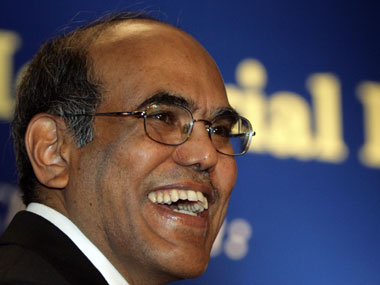In God we trust; all others must bring data, said W Edwards Deming, the late quality guru.
But surely Edwards would have thrown up his hands in despair if he saw the quality of data dished out in India. It would have destroyed his trust both in God and his data-generating flunkies.
[caption id=“attachment_37606” align=“alignleft” width=“380” caption=“RBI Governor D Subbarao. Reuters”]
 [/caption]
[/caption]
“We are handicapped by the reliability of some of the basic data that we need to use in policy calculations”, Reserve Bank Governor Duvvuri Subbarao cribbed on Tuesday.
Do we have something here, or is it merely a case of a bad carpenter blaming his tools? After all, Subbarao has been singularly unsuccessful in targeting inflation, and successive estimates have proved to be wildly off the mark. (He isn’t the only one though. From the Finance Minister to his advisors to the PM’s Economic Advisory Council, everyone got inflation wrong.)
In the opinion of Firstpost, it’s a bit of both. The data may be wrong, but one can’t blame it all on numbers. The RBI had, till recently, flunked the inflation test because it chose to ignore visible data. When people are shouting from the rooftops about food and vegetable prices, you don’t need a Wholesale Prices Index-however badly constructed-to tell you that inflation is the priority, not growth. Subbarao bit the bullet in May when he raised interest rates by 50 basis points in one fell swoop (100 basis points make 1%). He may have been late, but at least he boarded the bus to price stability.
When the economic variables are so many-oil prices, fiscal mismanagement, corruption scandals, global fund flows, etc.-no one set of data can really be meaningful even if it correct. For example, the big spends on NREGA have permanently changed the economics of agriculture, with all costs, and especially labour, going up dramatically.
Impact Shorts
More ShortsWith NREGA wages now being indexed, wages and prices will chase each other. Farming is now fairly unviable for most farmers without mechanisation. Inflation may thus have gone structural in India’s agri-economy with or without a good monsoon. So if Subbarao says that the monsoon data is unreliable, he should know that something more fundamental has changed that may go wrong independent of the rainfall.
In a complex economy, the Governor’s job is to manage the balance of risks and not look for reliability in any one set of indicators. He is the economy’s risk-manager. For example, there is no real comparable data on real estate prices. But when real estate prices are not falling and realty shares have crashed, he should know that banks that have lent money to this sector will be at risk. Action is needed no matter what the data show.
That said, the Governor is surely right about the kind of garbage being put out in the name of official stats. In recent months, all kinds of data have been flung at us - wrong numbers, contradictory data, delayed figures or information that is completely at variance with observed reality.
The recent National Sample Survey Office (NSSO) data on jobs, for example, shows a sharp drop in the labour force participation rate when the entire theme song of the UPA regime has been about creating rural jobs by the million through NREGA. How can we believe data that flies in the face of what one can see directly?
It’s not that the data are wrong. Firstpost brought you the debate among statisticians on whether the data were correctly collected or whether they are just wrongly analysed, and the consensus was that we could do better. However, if two people can come to widely divergent from the same set of numbers, there’s surely something wrong with the presentation of data at least?
Swaminathan Aiyar provided the best possible analysis of flawed NSSO data, pointing out that the real drop in the labour participation rate happened with women who dropped out the labour market when family incomes went up. However, he doesn’t explain the fact that more women are dropping out of the labour force in rural areas (where they surely need the money more) than in urban areas (where a stay-at-home spouse is apparently a signal of social status. Is it NREGA at work again? Are higher family incomes freeing women to do other things?
Subbarao’s other point, about the data being frequently revised , clearly shows that we are stuck in the stone age. When price data for February can be revised two months later, surely we can’t base the May monetary policy on April data, since they will get revised in June or July. “The RBI’s policy formulation is handicapped by frequent revisions to data. We make policies in real-time, and if the provisional data these are based on are inaccurate, the resultant policies can turn out to be sub-optimal choices,” said Subbarao.
Sure, they can. The Index of Industrial Production and the WPI are two cases in point. Firstpost pointed out in an article as early as May that frequent revisions to the price index meant that we are already into double-digit inflation . Most revisions have also been upward.
As for the IIP, the less said the better. The old IIP showed so many jarring dips in capital goods growth, that it foxed all analysts. The new index, introduced in June, may work better, but the contrast between the old and the new is stark. The old one showed a slowdown had already begun, while the new one didn’t show it convincingly. Net result: confusion.
Dr Subbarao, we empathise with you. Based on such numbers, you can’t decide whether rates should be pushed up or held. Looking out of your window to see what’s going on in the economy may be better.
Or he could try the astrologer.
)